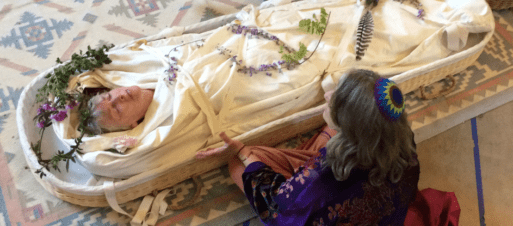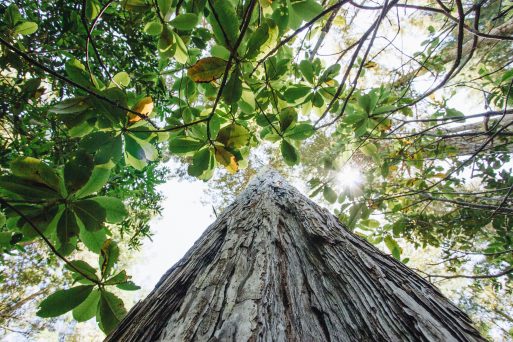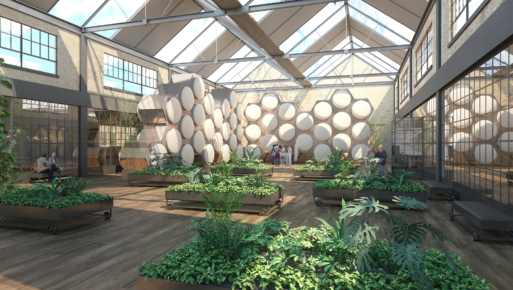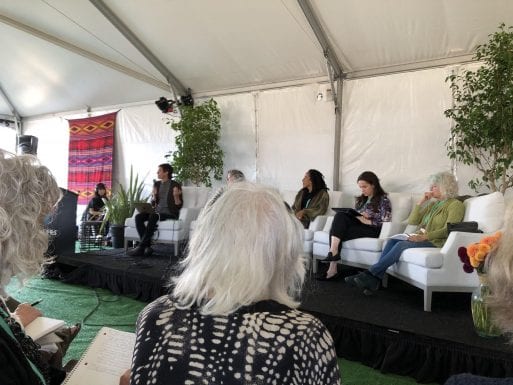
Credit: larkspurconservation.org
Humans are an innovative species. When presented with a problem, we adapt. For example, when the sheer numbers of dead bodies during the Civil War overwhelmed the living, humans invented embalming, and the funeral industry was born.
A century and a half later, humans were presented with another problem. The traditional funeral and burial service, complete with its cement vault, steel coffin and chemical-laden body, was becoming too heavy a financial burden for many Americans. It was the 1960s, and cultural shifts were at play. Religious prohibitions were weakening, environmentalism was entering the zeitgeist, and the idea of a preserved body and costly funeral as the only avenue to everlasting peace was falling out of vogue.
Cremation arose as a practical and cost-effective solution. From 1960 to 2015, the rate of cremation rose by 1400 percent, overtaking burial in 2015. And it was during this rapid takeover that another shift was happening — people were beginning to seek out “greener” ways to dispose of their bodies after death.
This seemed to be a natural progression of the environmental movement that began in the 1960s. By the mid-1990s, environmentalism had grown up. As a 1989 Los Angeles Times article put it, “In a simpler time, not so long ago, environmentalists talked about saving forests for hiking, streams for rafting and clean air for the pure enjoyment of breathing it. Now, as the 1990s approach, the talk has turned to the science of survival— saving forests for oxygen, keeping streams from spreading toxic pollutants, cleaning the air to avoid catastrophic global warming.”
As humans began to find creative solutions for greener ways to live, it made sense that they would look for greener ways to die. It isn’t new, after all. Many indigenous cultures have practiced aspects of green disposition for millennia, and some religions such as Islam and Judaism include natural burial practices in their traditions.

The use of a natural burial shroud is common in traditional Jewish funeral practices.
And while the modern “greening” of how we care for our bodies after death may have been catalyzed by environmentalism, there are different motivations and emotional narratives guiding people to those options.
Shifting Attitudes About Death and Disposition
When asked to comment on the observations she’s made of people’s shifting attitudes towards death and green disposition options, Lee Webster, Director of New Hampshire Funeral Resources, Education & Advocacy Organization and a writer, researcher and public speaker on all matters regarding the end of life, said, “In a nutshell, they are looking for options that reflect who they perceive they are right now in their own lives. People who are thoughtful about the ramifications of their own footprint want to leave the planet in ways that are compatible to the way they believe they have lived. [They] are looking for more affordable, meaningful and environmentally responsible funerals and dispositions because they believe they are agents of change in these areas.”
I surveyed others who had indicated an interest in a greener disposition, and many of the responses I received supported Webster’s observations. Some wanted to reduce their impact as much as possible. Said Robert Lind, a Las Vegas resident interested in green burial, “I’ve generally been concerned about the environment, and when I read about how much mercury is released when you’re cremated, I realized that was a problem for me. Basically when I’m gone, I don’t care what happens to the body — I just want to make the smallest footprint possible.”

Credit: steelmantowncemetery.com
And others, still, see their bodies as an inextricable part of the planet’s ecosystem and view greener disposition options as a way to live on and remain a part of the life cycle. Isoiata, a member of the subreddit r/death community, spoke to why she planned for a green burial, “I like the idea of being returned to the earth in a natural state where my body can be broken down and become fuel for new life. In a way it’s kind of like the closest we can come to immortality, because the basic building blocks that our bodies are made of have been around since [the] dawn of time, and they can become part of some new living things by giving them back to the earth. It feels wrong to have my body taken out of that natural system.”
Others see green disposition as a way to make a difficult time more simple. Katie Gagnon, President of Connecticut Green Burial Grounds, commented, “I would add that the majority of people who reach out to learn more about green burial are looking for simplicity. It really is that simple. There’s something to be said for simplicity when considering your own mortality or the death of a loved one, and I think green burial offers exactly that.”
The Many Shades of Green
Jonas Zahn, founder of the Northwoods Casket Company, a biodegradable casket building business in Wisconsin, is on the forefront of the green burial movement. The very definition of environmentally friendly, the company uses local lumber sources and non-toxic materials, and they plant 100 trees for every casket they sell. They also offer natural cotton burial shrouds and trundles.

Zahn showing a group how to use a natural burial shroud.
Credit: northwoodscasket.com
Interestingly, Zahn notes that families will choose one of their caskets for any one of those ecological benefits, even though they may choose to be interred in a traditional cemetery with a vault, where their family is buried. Zahn says, “We call that the many shades of green for a natural burial.”
But to restrict our idea of green or natural disposition to only burial is to limit the innovative, varied spirit of the movement.
For example, companies like Eternal Reefs and Better Place Forests utilize cremation ashes with an aim to improve the environment. Eternal Reefs offers those who are concerned about the rapid death of the ocean’s coral reefs a chance to improve it by incorporating their ashes into a concrete, artificial reef.
Better Place Forests focuses on land conservation. Conservation death care can include burial at a conservation burial ground, such as Larkspur Conservation Burial Ground, or through other methods like those of Better Place Forests. It’s different from “green burial” in that the organization usually uses burial fees to pay for land acquisition, protection, restoration and management. Better Place Forests buys forests and arranges conservation easements to protect the land from being developed. They then sell people the right to choose a specific tree as “theirs” and then have their cremated remains mixed with fertilizer and fed to it. The tree becomes their grave marker, and the money paid protects the land from development.

A coastal redwood in Point Arena, California, one of the first Better Place Forests locations
Credit: betterplaceforests.com
Which brings us to cremation. While cremation is considered to have less of an environmental impact than traditional interment, the process isn’t necessarily considered “green.” The culprits are the amount of energy required, the carbon dioxide emitted and the estimated amount of vaporized mercury (from dental fillings) and other particulate matter released into the air during the process. A mercury flow worksheet in 2005 for EPA Region V of the United States estimated that 6,613 lbs of mercury were released into the environment from crematories. However, there’s a lack of consistent data. Because crematories are not classified as “solid-waste incinerators,” they don’t fall under the guidelines of the Clean Air Act and are free from EPA regulation.

This image of a control panel of a cremation retort in Santa Cruz, California, demonstrates how technology has come a long way to assist in after death care.
That lack of data has led to a standstill between the cremation industry, crematories and some environmental groups and state health officials. In the past, some states and local agencies have introduced legislation to require the addition of a filtration system to minimize emissions (or even the removal of teeth with mercury fillings). Crematory operators contend that the $500,000 price tag for a filtration system is prohibitive to many, especially since they feel there’s no data to back it up. Despite the pushback, in 2005, the United Kingdom began requiring that all new and old crematories be fitted with filtering equipment to cut mercury emissions by half by 2012.
In a way, the approach taken by Eternal Reefs and Better Place Forests is akin to buying carbon credits. Both are great examples of ways to memorialize someone in a way that is personally meaningful while attempting to mitigate the environmental impact of cremation. After all, someone who is cremated could literally have their ashes scattered anywhere, for free. To choose to pay $3,000 to $30,000 to be turned into an artificial reef or mixed into the soil at the base of a tree seems driven by something more personal.
Perhaps this is what Webster meant when she commented that a person’s motivation for greener disposition usually “involves self-identification with methods and products that are in sync with their version of integrity and authenticity.”

Alkaline Hydrolysis is being offered in some state-of-the-art funeral homes with the added comfort of a private room with a chamber for a service like this one in Stillwater, Minnesota.
Credit: greencremation.com
For some, alkaline hydrolysis, also known as resomation, aquamation, or water cremation, is most aligned with their version of environmental integrity. Proponents claim it is one of the most eco-friendly ways to dispose of a body to date, though there is no definitive data to support this claim. Nonetheless, it is currently legal in 19 states and three provinces.
Ed Gazvoda, inventor of the Alkaline Hydrolysis 2.0 process (patent pending) and founder of Sustainable Funeral in Arvada, Colorado, explained to me how his system works. “Your body is carbon-based; you have about 70 percent water and a bunch of nutrients in you. Besides that, you also have viruses, bacteria, medical implants, and most people have about three grams of mercury in their teeth. With our process, the body is placed into our stainless steel New Life Chamber. We add potassium hydroxide, which is basically lye, along with water and an accelerant — which is a natural lipophilic compound — to speed up the process. In less than two hours of heating the body to about 150 degrees Fahrenheit, we’re able to get complete dissolution. All that’s left are bone fragments, any medical implants and this beautiful, rich nutrient.”

Containers of effluent from Alkaline Hydrolysis 2.0 and
a small tree that’s also given to the families
Credit: Ed Gazvoda
The beautiful, rich nutrient Gazvoda calls “essence” is also known as “effluent” in the alkaline hydrolysis industry. It is a sterile, pathogen-free liquid (cleaner than most wastewater), that’s a mix of salts, sugars, amino acids and peptides, with no tissue or DNA. The process used by Gazvoda renders a coffee-colored, nitrogen-phosphorus-potassium mix that’s full of micro-nutrients — literally, liquid fertilizer, an incredible bio-plant stimulant. According to Gazvoda, 95 percent of the families who choose this process will take some or all of the effluent to use in their gardens.
Gazvoda says the primary reasons why people choose his services is because they want their body to go back to the earth, and they also don’t want to harm the people, the pets, the places that they love. “Even if they’ve never done anything good their whole life, they want to do something good with their death. We’re human, most of us fear death. We don’t look forward to it, we don’t think about it, that’s not how we live. But to see someone who has died become something that’s useful for the planet … it’s very uplifting.”
Katrina Spade, founder of the Seattle-based company Recompose, had the same idea. Using a modular, reusable vessel with a perfect environment of wood chips, heat and aeration, Spade has created a way to turn a body into compost in 30 days, a process dubbed “natural organic reduction.” The idea is that the loved one’s family can use the soil to plant a tree or a flower garden, or they can scatter it as one would cremation ashes.

Rendering of a proposed Recompose site
Credit: Recompose.life
Research conducted by Dr. Lynne Carpenter-Boggs, Professor of Science at Washington State University, found the process resulted in compost that met and “sometimes exceeded” state and federal safety standards for pathogens and metals that could be dangerous to humans, animals, or nearby plants. In 2019, the Washington State legislature found the research sufficiently compelling to legalize both alkaline hydrolysis and natural organic reduction as acceptable means of disposition for human bodies.

Katrina Spade speaking at the 2019 Bioneers conference in Marin, California, along with other experts who are also creating change around the end of life. A whole host of conferences that have cropped up around the topic illustrate how hungry the public is for information and options to meet their shifting attitudes about death.
Recompose plans to open for operations by early 2021, and according to their spokesperson, they hear from people every day who are eager to make Recompose their death care choice. As to their motivations for pursuing natural organic reduction, she commented, “Sustainability is the most common reason people share with us regarding why Recompose resonates with them. [They’ve] also listed personal resonance, like the gardener or a love for the outdoors. We’ve heard the company’s values and the innovation aspect are also compelling differentiators.”
On the other end of the spectrum is the Infinity Burial suit, a burial product created by artist Jae Rhim Lee. The suit’s function is based on the premise that our bodies are toxic storehouses that leech poison into the ground. Covered in mushroom mycelia and other microorganisms, the suit is intended to break down and remediate the toxins in our body. It was recently brought into the spotlight when Luke Perry was buried in one.
However, there is little evidence that the Infinity Burial Suit is actually effective or even necessary for a more ecological disposition of one’s body. Yes, being buried in an Infinity Burial Suit in a green cemetery will be more environmentally friendly than a traditional burial with the use of embalming fluids, non-biodegradable coffins and concrete vaults. But when compared to a simple shroud used in a green burial, the suit seems like a superfluous expense.
This brings up the “newness” of this green disposition industry, the premature nature of some of the claims made, and the need for critical examination of our choices.
For example, Elisabeth Keijzer, researcher with the Netherlands Organisation for Applied Scientific Research, found that a funeral service can have three times the environmental impact of the burial itself. The degree of that impact is determined by the people involved. Along similar lines, architect and attorney Dr. Brad Angell recently gave a presentation at a 2019 Funeral Consumers Alliance meeting in Santa Cruz, pinpointing the need for a “full cycle analysis” to determine if methods that claim to be green are actually green.
As someone who comes from the zero-waste world, Angell suggests there is a way to analyze and measure the environmental impact of these different methods. “When I did the presentation for the FCA, I wanted to do what I’ve done for sustainability. For example, there are these energy conservation codes that you have to do when you build anything, they have all these economic and fiscal and environmental analysis that you could analogize to the death process. You could figure it out with each different type [of disposition method] and get a sum number. Then you can start figuring stuff out with cremation and get a carbon-neutral process — that’s what I was interested in pursuing. I have an architecture and legal background and I’m crossing a lot of disciplines, so I’ve seen this done and it makes sense to me. I think Recompose were going pretty deep into the data on their process, but I’d like to dig into it more.”
Regardless of their proven effectiveness, what these new disposition methods capture is people’s desire to not just minimize the negative effects of their death care choice but also maximize their positive impact, whether it be through protecting forests, improving marine life, becoming bio-plant stimulant, or furthering scientific research with body farms.
But to think that greener dispositions are only sought after by the stereotypical “environmentalist” again limits our perspective. As Kate Kalanich, the Green Burial Council’s executive director, has said, “I have had ranchers and farmers from the Midwest contact me, who are not really environmentally conscious, but have worked the land their whole life. They just want to give their body back to it when they die.”

Midwest ranchers are also exhibiting changing attitudes about death with an interest in being one with their land when they die.
Credit: nature.org
A common thread, no matter how people want to be disposed of after they die, is a shared perspective of wanting to be returned to the earth with a little more simplicity.
According to Webster, “I find that many of the people who are interested in green burial want to leave the planet in better shape than when they arrived, and for many, that means simply disappearing — no monuments, no junk for others to have to contend with, just a natural place to call home for their body until it is gone. Sense of place is more important to the living.”
This shift acknowledges a tearing down of old beliefs that we, as humans, are entitled to our own property on the planet, even when we are no longer living upon it. It’s a reexamination of the idea that “respect of the dead” requires a denial of death through preservation, embalming, metal coffins and a concrete vault.
As Connecticut Green Burial Grounds’ Katie Gagnon says about why she is choosing a green burial, “Personally, I want a natural burial because it is the least invasive option and a return to older practices … to me it is the only option that doesn’t attempt to hide death. I’m a firm believer that we shouldn’t hide death, but rather discuss it openly and honestly and face it, along with our fears and concerns.”
Death Acceptance and Power to the People
The experience of feeling disappointed, unfulfilled, or even angry with the funeral and burial process is what many leaders in this green disposition movement have cited as the catalyst that led them to become involved. When Kate Kalanick’s mom died unexpectedly, the coroner pushed for embalming. She resisted and was told, “No embalming, no visitation.” She chose no visitation. Like others, she would have preferred another route, but didn’t know there were other options available.
Currently, there are very few federal laws around the handling of the dead. Around half of U.S. states regulate the amount of time a body can be left unembalmed or unrefrigerated (usually, 24 to 48 hours). However, no state or local law requires a person to be embalmed for burial or buried in a coffin or concrete vault, except in rare circumstances.
Given this loose legal framework, it seems like it would be easy for natural burial, at-home funerals and other green dispositions to thrive. But change is slow, and options are unknown to many and not welcomed by all. The funeral industry, primarily funded by the National Funeral Directors Association, has done their fair share of lobbying, especially from 2008 to 2012, with lobbying for funeral services surging to nearly $900,000 (up from annual averages of $300,000). Much of this lobbying was intended to mandate embalming or require the involvement of a funeral director to sign a death certificate or perform other tasks that could just as easily be completed by the family.
Restricting our freedom to access natural options isn’t just bad for the environment, it takes the control out of our hands. And when it comes to death, being able to choose what happens to our own bodies (or our loved one’s bodies) after we die can be vital to the grieving process.
As Ed Bixby, owner of Steelmantown Natural Cemetery, a green burial cemetery in New Jersey, said, “This cemetery is about life, it’s not about death. Death is painful, but this can ease the pain, it can make you want to come back and visit your loved ones. By giving the family the control back, by taking the family from being the spectator and empowering them to be the participants again, I’ve realized it has become a real cathartic, healing process.”
A desire to participate in the process has given way to the rise of home funerals. According to the National Home Funeral Alliance, due to a lack of data, it is impossible to determine how many home funerals happen per year. We can only guess based upon the general cultural shift and the increase in alternative burial businesses, funeral consultants and home funeral guides. Consultants and guides often help with the home funeral process, working with both the dying and the bereaved to help give them the control, respect and intimacy deserved in grieving, dying and post-death processes.

Death doula Aula Arthur leading a death meditation
Credit: facebook.com
For example, death doulas provide a range of services, but primarily work with the dying and families of the dying to help them achieve a “conscious death.” I spoke with Aula Arthur, a death doula, attorney, adjunct professor and ordained minister who runs Going with Grace, an end-of-life support and planning service, about changing attitudes toward death and the services she offers. “It has grown tremendously over the last seven years,” she said. “People didn’t even know [death doulas] existed, but now public perception is shifting about how we die, and interest is growing.”
On what her clients are looking for, Arthur said, “They have a need that’s not being met. The specifics of what they request varies — some people want practical help with handling affairs or facilitating conversations, while others want to figure out how to create a ritual around dying or just want someone to talk to. But the commonality is that they feel they have a need that hasn’t been met elsewhere.”
As modern consumers continue to learn more about death care, they will continue to seek options that align with their needs — options that will allow them and their loved ones more control, more intimacy and more acceptance of death.

 The New Immortality: Shifting Attitudes About Death, Our Bodies and the Environment
The New Immortality: Shifting Attitudes About Death, Our Bodies and the Environment


 “Songbird” by Fleetwood Mac
“Songbird” by Fleetwood Mac

 How to Comfort A Dying Loved One
How to Comfort A Dying Loved One














